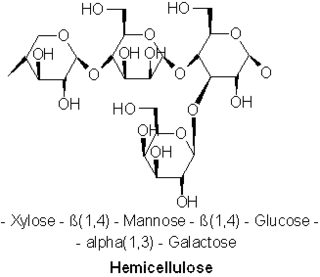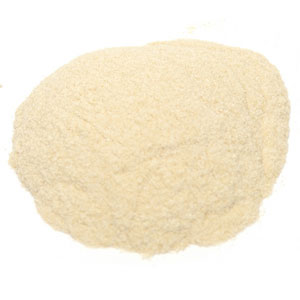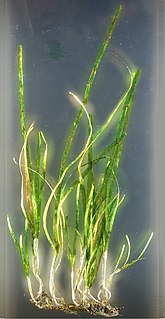Related Research Articles

In organic chemistry, a carbohydrate is a biomolecule consisting of carbon (C), hydrogen (H) and oxygen (O) atoms, usually with a hydrogen–oxygen atom ratio of 2:1 and thus with the empirical formula Cm(H2O)n. However, not all carbohydrates conform to this precise stoichiometric definition, nor are all chemicals that do conform to this definition automatically classified as carbohydrates.

A hemicellulose is one of a number of heteropolymers, such as arabinoxylans, present along with cellulose in almost all terrestrial plant cell walls. Cellulose is crystalline, strong, and resistant to hydrolysis. Hemicelluloses are branched, shorter in length than cellulose, and also show a propensity to crystallize. They can be hydrolyzed by dilute acid or base as well as a myriad of hemicellulase enzymes.

Polysaccharides, or polycarbohydrates, are the most abundant carbohydrates found in food. They are long chain polymeric carbohydrates composed of monosaccharide units bound together by glycosidic linkages. This carbohydrate can react with water (hydrolysis) using amylase enzymes as catalyst, which produces constituent sugars. They range in structure from linear to highly branched. Examples include storage polysaccharides such as starch, glycogen and galactogen and structural polysaccharides such as cellulose and chitin.

Pectin is a structural acidic heteropolysaccharide contained in the primary and middle lamella and cell walls of terrestrial plants. Its main component is galacturonic acid, a sugar acid derived from galactose. It was first isolated and described in 1825 by Henri Braconnot. It is produced commercially as a white to light brown powder, mainly extracted from citrus fruits, and is used in food as a gelling agent, particularly in jams and jellies. It is also used in dessert fillings, medicines, sweets, as a stabiliser in fruit juices and milk drinks, and as a source of dietary fiber.

Seagrasses are the only flowering plants which grow in marine environments. There are about 60 species of fully marine seagrasses which belong to four families, all in the order Alismatales. Seagrasses evolved from terrestrial plants which recolonised the ocean 70 to 100 million years ago.

A biomolecule or biological molecule is a loosely used term for molecules present in organisms that are essential to one or more typically biological processes, such as cell division, morphogenesis, or development. Biomolecules include large macromolecules such as proteins, carbohydrates, lipids, and nucleic acids, as well as small molecules such as primary metabolites, secondary metabolites and natural products. A more general name for this class of material is biological materials. Biomolecules are an important element of living organisms, those biomolecules are often endogenous, produced within the organism but organisms usually need exogenous biomolecules, for example certain nutrients, to survive.

Teicoplanin is an antibiotic used in the prophylaxis and treatment of serious infections caused by Gram-positive bacteria, including methicillin-resistant Staphylococcus aureus and Enterococcus faecalis. It is a semisynthetic glycopeptide antibiotic with a spectrum of activity similar to vancomycin. Its mechanism of action is to inhibit bacterial cell wall synthesis.

Tremella mesenterica is a common jelly fungus in the family Tremellaceae of the Agaricomycotina. It is most frequently found on dead but attached and on recently fallen branches, especially of angiosperms, as a parasite of wood decay fungi in the genus Peniophora. The gelatinous, orange-yellow fruit body of the fungus, which can grow up to 7.5 cm (3.0 in) diameter, has a convoluted or lobed surface that is greasy or slimy when damp. It grows in crevices in bark, appearing during rainy weather. Within a few days after rain it dries into a thin film or shriveled mass capable of reviving after subsequent rain. This fungus occurs widely in deciduous and mixed forests and is widely distributed in temperate and tropical regions that include Africa, Asia, Australia, Europe, North and South America. Although considered bland and flavorless, the fungus is edible. Tremella mesenterica produces carbohydrates that are attracting research interest because of their various biological activities.

Xylan is a type of hemicellulose, a polysaccharide consisting mainly of xylose residues. It is found in plants, in the secondary cell walls of dicots and all cell walls of grasses. Xylan is the third most abundant biopolymer on Earth.
Sulfation is the chemical reaction that entails the addition of SO3 group. In principle, many sulfations would involve reactions of sulfur trioxide (SO3). In practice, most sulfations are effected less directly. Regardless of the mechanism, the installation of a sulfate-like group on a substrate leads to substantial changes.
Xyloglucan is a hemicellulose that occurs in the primary cell wall of all vascular plants; however, all enzymes responsible for xyloglucan metabolism are found in Charophyceae algae. In many dicotyledonous plants, it is the most abundant hemicellulose in the primary cell wall. Xyloglucan binds to the surface of cellulose microfibrils and may link them together. It is the substrate of xyloglucan endotransglycosylase, which cuts and ligates xyloglucans, as a means of integrating new xyloglucans into the cell wall. It is also thought to be the substrate of alpha-expansin, which promotes cell wall enlargement.

Lemna minor, the common duckweed or lesser duckweed, is a species of aquatic freshwater plant in the subfamily Lemnoideae of the arum family Araceae. L. minor is used as animal fodder, bioremediator, for wastewater nutrient recovery, and other applications.
Arabinogalactan, also known as galactoarabinan, larch arabinogalactan, and larch gum, is a biopolymer consisting of arabinose and galactose monosaccharides. Two classes of arabinogalactans are found in nature: plant arabinogalactan and microbial arabinogalactan. In plants, it is a major component of many gums, including gum arabic and gum ghatti. It is often found attached to proteins, and the resulting arabinogalactan protein (AGP) functions as both an intercellular signaling molecule and a glue to seal plant wounds.
Porphyran is a sulfated carbohydrate derived from red algae of the genus Porphyra.

Rhamnogalacturonan-II (RG-II) is a complex polysaccharide component of pectin that is found in the primary cell walls of dicotyledonous and monocotyledonous plants and gymnosperms. It is supposed to be crucial for the plant cell wall integrity. RG-II is also likely to be present in the walls of some lower plants. Its global structure is conserved across vascular plants, albeit a number of variations within the RGII side chains have been observed between different plants. RG-II is composed of 12 different glycosyl residues including D-rhamnose, D-apiose, D-galactose, L-galactose, Kdo, D-galacturonic acid, L-arabinose, D-xylose, and L-aceric acid, linked together by at least 21 distinct glycosidic linkages. Some resides are further modified via methylation and acetylation. It moreover supports borate mediated cross-linking between different RGII side-chain apiosyl residues. The backbone consists of a linear polymer of alpha-1,4-linked D-galactopyranosiduronic acid. RG-II can be isolated from different sources, such as apple juice and red wine.
Arabinogalactan-proteins (AGPs) are highly glycosylated proteins (glycoproteins) found in the cell walls of plants. Each one consists of a protein with sugar molecules attached. They are members of the wider class of hydroxyproline (Hyp)-rich cell wall glycoproteins, a large and diverse group of glycosylated wall proteins.

Bacterial cellulose is an organic compound with the formula (C
6H
10O
5)
n produced by certain types of bacteria. While cellulose is a basic structural material of most plants, it is also produced by bacteria, principally of the genera Acetobacter, Sarcina ventriculi and Agrobacterium. Bacterial, or microbial, cellulose has different properties from plant cellulose and is characterized by high purity, strength, moldability and increased water holding ability. In natural habitats, the majority of bacteria synthesize extracellular polysaccharides, such as cellulose, which form protective envelopes around the cells. While bacterial cellulose is produced in nature, many methods are currently being investigated to enhance cellulose growth from cultures in laboratories as a large-scale process. By controlling synthesis methods, the resulting microbial cellulose can be tailored to have specific desirable properties. For example, attention has been given to the bacteria Komagataeibacter xylinum due to its cellulose's unique mechanical properties and applications to biotechnology, microbiology, and materials science. Historically, bacterial cellulose has been limited to the manufacture of Nata de coco, a South-East Asian food product. With advances in the ability to synthesize and characterize bacterial cellulose, the material is being used for a wide variety of commercial applications including textiles, cosmetics, and food products, as well as medical applications. Many patents have been issued in microbial cellulose applications and several active areas of research are attempting to better characterize microbial cellulose and utilize it in new areas.
Beta porphyranase is an enzyme responsible for the degradation of porphyran, which composes the cell wall of red algae. So far only five β-porphyranases have been identified: PorA and PorB are found in the marine bacteria Zobellia galactinovirans. A wild-type porphyranase activity has been found in Pseudoalteromonas atlantica. BpGH16B and BpGH86A have been found in the human gut bactrium, Bacteroides plebeius, of Japanese individuals.

Galactogen is a polysaccharide of galactose that functions as energy storage in pulmonate snails and some Caenogastropoda. This polysaccharide is exclusive of the reproduction and is only found in the albumen gland from the female snail reproductive system and in the perivitelline fluid of eggs.
Ulvan lyase is an enzyme found within the cell-wall of the marine organism Ulvales, and some marine bacterium. A lyase is a class of enzyme that catalyzes the breakdown of chemical bonds through an elimination reaction mechanism, rather than a substitution reaction mechanism. Ulvan lyase belongs to the polysaccharide lyase family, a type of enzyme that primarily functions to cleave glycosidic linkages in polysaccharides.
References
- ↑ Gunter, E.A. (2004). "Isolation of Polysaccharides from the Callus Culture of Lemna minor L.". Applied Biochemistry and Microbiology. 40: 80–83. doi:10.1023/B:ABIM.0000010359.68528.fe. S2CID 23940747.
- ↑ "Plant Cell Walls". Complex Carbohydrate Research Center. University of Georgia. Retrieved 29 April 2020.
- ↑ Khasina, E.I. (2003). "Gastroprotective effect of lemnan, a pectic polysaccharide from Lemna minor L". Doklady Biological Sciences. 390: 204–206. doi:10.1023/A:1024437012646. PMID 12940141. S2CID 27423842.
- ↑ Jin-Hui, Kim; Kyung-Eun, Lee; Jin-Hwa, Kim; Young-Ho, Cho; et al. (January 2004). "New Cosmetic Agents for Anti-aging from Zostera marina L." . Journal of the Society of Cosmetic Scientists of Korea. 30.